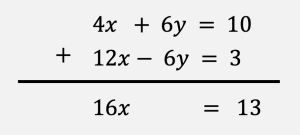Solving a System of Equations
To read this book you will need to be comfortable with solving systems of equations. We’ll go through how to do this within the context of a specific problem first.
Example: Solving Systems of Equations
For example, consider two equations with two unknowns ![]() and
and ![]() given by
given by
![]()
![]()
Find ![]() .
.
Solution: The first thing we notice is that if we want to solve ![]() , we don’t care about
, we don’t care about ![]() . Therefore, we have to get rid of
. Therefore, we have to get rid of ![]() .
.
Here is the key insight: if the coefficient of ![]() is the same in both equations, we can add/subtract the two equations to get rid of
is the same in both equations, we can add/subtract the two equations to get rid of ![]() .
.
To make the coefficient of ![]() of the two equations the same, we can just multiply each equation by the appropriate coefficient.
of the two equations the same, we can just multiply each equation by the appropriate coefficient.
Let’s see this in action. In this case, we see the coefficient of ![]() in the first equation is 3. So- let’s multiply the second equation by 3. Likewise, the coefficient of the second equation is 2 (before we mess with it), so we multiply the first equation by 2. This makes the coefficient of both equations “6”.
in the first equation is 3. So- let’s multiply the second equation by 3. Likewise, the coefficient of the second equation is 2 (before we mess with it), so we multiply the first equation by 2. This makes the coefficient of both equations “6”.
![]()
![]()
 Since the coefficients of
Since the coefficients of ![]() match with opposite signs, we add the two equations. I like to “line up” the equations so that each “column” has only one kind of variable as shown in the picture below.
match with opposite signs, we add the two equations. I like to “line up” the equations so that each “column” has only one kind of variable as shown in the picture below.
At this point, we have one equation with one unknown, which can easily solve. In this case, ![]() .
.
If we need to find both ![]() and
and ![]() , now that we know what
, now that we know what ![]() is, we can substitute
is, we can substitute ![]() in either of our original two equations, and solve for
in either of our original two equations, and solve for ![]() .
.
In the example above, I use numerical coefficients in front of ![]() and
and ![]() to make the algebra look less intimidating, but please notice that the pattern we followed doesn’t care at all about what the coefficient in front of
to make the algebra look less intimidating, but please notice that the pattern we followed doesn’t care at all about what the coefficient in front of ![]() is.
is.
In other words, the method for solving these equations is:
- Identify the variable you do NOT care about.
- Multiply equation 1 by the coefficient of “variable you don’t care about” in equation 2, and multiply equation 2 by the coefficient of “variable you don’t care about” in equation 1.
- Add/Subtract the two equations to get rid of the variable you don’t care about.
To help you remember this, you can summarize this whole thing simply as the “add equations to get rid of variables you don’t care about” method.
Exercise: Solving Systems of Equations
To make sure we get it, let’s solve the most general form of two linear equations with two unknowns. That is, we will solve for both ![]() and
and ![]() in the following set of equations.
in the following set of equations.
![]()
![]()
What if we had three equations with three unknowns? The method is exactly the same. Say the unknowns are ![]() ,
, ![]() , and
, and ![]() . You want to solve for
. You want to solve for ![]() . Here’s how we do it.
. Here’s how we do it.
- Choose two of the original equations. Use these two equations to get rid of one of the variables you don’t care about (e.g.
 ). This gives you one new new equation with only
). This gives you one new new equation with only  and
and  in it.
in it. - Now choose another set of two of the original equations. Once again, get rid of
 . This gives a second new equation with only
. This gives a second new equation with only  and
and  in it.
in it. - The two new equations from step 1 and 2 are a system of two equations with two unknowns, which you already know how to solve!
Ta-daa! Using the “add equations to get rid of variables you don’t care about” method we’ve solved a system of three equations with three unknowns.
Note too that if in the original set of 3 equations there is one equations that only has two unknown variables, then you just saved yourself a step. Choose the other two equations, and get rid of the “third” variables. Let’s do an example.
Exercise: Three Equations with Three Unknowns.
Solve for ![]() in the following set of equations.
in the following set of equations.
![]()
![]()
![]()
